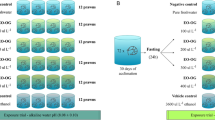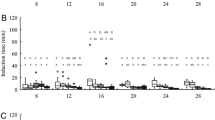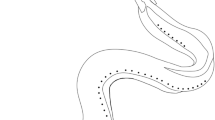Abstract
The use of clove oil as a potential anaesthetic for freshwater amphipods was examined at 20 °C. Individuals of Gammarus minus, a common species in southern Illinois, USA, spanning the entire body size range (4.3–14.3 mm), were used to test four anaesthetic concentrations varying from 1.48 × 10−4 ml ml−1 to 5.9 × 10−4 ml ml−1. Small-bodied individuals (mean size = 5.4 mm ± 0.27SE) were used to test additional concentrations, up to 14.7 × 10−4 ml ml−1, a 10-fold span, to identify potential lethal concentrations. At the lowest concentration, time to anaesthesia and recovery was constant at all body sizes. For the three next higher concentrations, time to anaesthesia decreased with increasing concentration while recovery time increased. Activity of amphipods was not affected by the ethanol carrier. In addition, activity did not differ between amphipods that had recovered from anaesthesia and unexposed amphipods. At clove oil concentrations of 8.84 × 10−4 ml ml−1 and 14.7 × 10−4 ml ml−1, mortality was 7 and 40%, respectively, indicating, that 5.9 × 10−4 ml ml−1 was a safe working concentration. No mortality was observed with Gammarus acherondytes, a federally endangered cave amphipod on which the protocol with 80 μl of stock was used in the field. The method enabled us to obtain information on the endangered amphipod which normally would have required the sacrifice of individuals. Thus, research can continue on species for which population numbers are low and for which basic information is needed to formulate meaningful recovery plans.
Similar content being viewed by others
References
Ackerman J. L. and Bellwood D. R. (2002). Comparative efficiency of clove oil and rotenone for sampling tropical reef fish assemblages. Journal of Fish Biology 60: 893–901
Ahmad M. F. (1969). Anaesthetic effects of tricane methane sulphonate (MS 222 Sandoz) on Gammarus pulex (L.) (Amphipoda). Crustaceana 16: 197–201
Andrews P. L. R. and Tansey E. M. (1981). The effects of some anaesthetic agents in Octopus vulgaris. Comparative Biochemistry and Physiology 70C: 241–247
Araujo R., Remón J. M., Moreno D. and Ramos M. A. (1995). Relaxing techniques for freshwater molluscs: trials for evaluation of different methods. Malacologia 36: 29–41
Bower J. R., Sakurai Y., Yamamoto J. and Ishii H. (1999). Transport of the ommastrephid squid Todarodes pacificus under cold-water anesthesia. Aquaculture 170: 127–130
Brown J. H., McCauley S., Ross B., Taylor A. and Huntingford F. (2003). A test of two methods for marking larvae and post larvae of the giant freshwater prawn, Macrobrachium rosenbergii. Aquaculture Research 34: 49–54
Brown P. B., White M. R., Chaille J., Russell M. and Oseto C. (1996). Evaluation of three anesthetic agents for crayfish (Orconectes virilis). Journal of Shellfish Research 15: 433–435
Ferraro E. A. and Pressacco L. (1996). Anesthetic procedures for crustacea. An assessment of isobutanol and xylazine as general anaesthetics for Squilla mantis (Stomatopoda). Memorie di Biologia Marina e di Oceanografia 12: 471–475
Foley D. M., Stewart J. E. and Holley R. A. (1966). Isobutyl alcohol and methyl pentynol as general anesthetics for the lobster, Homarus americanus Milne-Edwards. Canadian Journal of Zoology 44: 141–143
Gardner C. (1997). Options for humanely immobilizing and killing crabs. Journal of Shellfish Research 16: 219–224
Hoskonen P. and Pirhonen J. (2004). Temperature effects on anaesthesia with clove oil in six temperate-zone fishes. Journal of Fish Biology 64: 1136–1142
Kahn, C. M., 1998. [Online]. Merck Veterinary Manual 8th edition online version. Merck and Co., Inc. Whitehouse Station, NJ, USA. Available: http://www.merckvetmanual.com/mvm/index.jsp?cfile=htm/bc/170204.htm (Table 01 Drugs for use in Aquaculture). November 24, 2005
Lellis W. A., Plerhoples T. A. and Lellis K. A. (2000). Evaluation of potential anesthetics for the freshwater mussel Elliptio complanata. Journal of Shellfish Research 19: 983–990
Lewis, J. J., 2000. Establishing a methodology for non-lethal censusing of Gammarus acherondytes populations in cave stream communities of southwestern Illinois. Final Report, Endangered Species Program, US Fish and Wildlife Service, and Endangered Species Program, Illinois Department of Natural Resources. 35 pp
Lewis, J. J., 2003. The 2003 non-lethal censusing of Gammarus acherondytes communities on southwestern Illinois. Final Report Endangered Species Program, US Fish and Wildlife Service. 61 pp
Marine Biological Laboratory (MBL), 2005. [Online]. Biological Bulletin Compendia: Anesthetic, Relaxant, and Narcotizing Agents for Aquatic Invertebrates. Available: http://www.mbl.edu/BiologicalBulletin/ANESCOMP/AnesComp-Lit.html. November 24, 2005
Marking L. L. and Meyer F. P. (1985). Are better anesthetics needed in fisheries?. Fisheries 10: 2–5
McKenzie J. D., Calow P. and Nimmo W. S. (1992). Effects of inhalational general anesthetics on intact Daphnia magna (Cladocera, Crustacea). Comparative Biochemistry and Physiology C-Pharmacology Toxicology & Endocrinology 101: 9–13
Norton J. H., Dashorst M., Lansky T. M. and Mayer R. J. (1996). An evaluation of some relaxants for use with pearl oysters. Aquaculture 144: 39–52
Quigley M. A. and Lang G. A. (1989). Measurement of amphipod body length using a digitizer. Hydrobiologia 171: 255–258
Rasband, W. S., 1997. [Online] ImageJ, US National Institutes of Health, Bethesda, Maryland, USA. Available: http://rsb.info.nih.gov/ij/, 1997-2005. November 24, 2005
Roubach R., Gomez L. C., Fonesca F. A. and Val A. L. (2005). Eugenol as an efficacious anaesthetic for tambaqui, Colossoma macropomum (Cuvier). Aquaculture Research 36: 1056–1061
(2003). SAS/STAT User’s Manual. SAS Institute Inc., Cary, N.C
Sokal R. R. and Rohlf F. J. (1995). Biometry. Freeman, New York, N.Y
Soto C. G. (1995). Clove oil as a fish anaesthetic for measuring length and weight of rabbitfish (Siganus lineatus). Aquaculture 136: 149–152
Summerfelt R. C. and Smith L. C. (1990). Anesthesia, surgery and related techniques. In: Schreck, C. B. and Moyle, P. B. (eds) Methods for Fish Biology, pp 213–272. American Fisheries Society, Bethesda, MD
Taylor P. W. and Roberts S. D. (1999). Clove oil: an alternative anaesthetic for aquaculture. North American Journal of Aquaculture 61: 150–155
United States Food and Drug Adminstration (USFDA), 2002. Status of clove oil and eugenol for anesthesia of fish. Guidance for Industry, Vol. 150: 4 pp
(2002). Illinois cave amphipod(Gammarus acherondytes) recovery plan. US Fish and Wildlife Service, Ft. Snelling, MN, 63
Venarsky, M. P., 2005. The life history and population genetics of the endangered Illinois cave amphipod, Gammarus acherondytes (Gammaridae). M.S. Thesis, Southern Illinois University, Carbondale, Carbondale, IL. 72 pp
Wagner G. N., Singer T. D. and McKinley R. S. (2003). The ability of clove oil and MS-222 to minimize handling stress in rainbow trout (Oncorhynchus mykiss Walbaum). Aquaculture Research 34: 1139–1146
Wilhelm F. M., Venarsky M. P., Taylor S. J. and Anderson F. E. (2003). Survival of Gammarus troglophilus (Gammaridae) after leg removal: evaluation of a procedure to obtain tissue for genetic analysis of rare and endangered amphipods. Invertebrate Biology 122: 369–374
Woolsey J., Holcomb M. and Ingerman R. L. (2004). Effect of temperature on clove oil anesthesia in steelhead fry. North American Journal of Aquaculture 66: 35–41
Author information
Authors and Affiliations
Corresponding author
Rights and permissions
About this article
Cite this article
Venarsky, M.P., Wilhelm, F.M. Use of clove oil to anaesthetize freshwater amphipods. Hydrobiologia 568, 425–432 (2006). https://doi.org/10.1007/s10750-006-0225-x
Received:
Revised:
Accepted:
Published:
Issue Date:
DOI: https://doi.org/10.1007/s10750-006-0225-x




